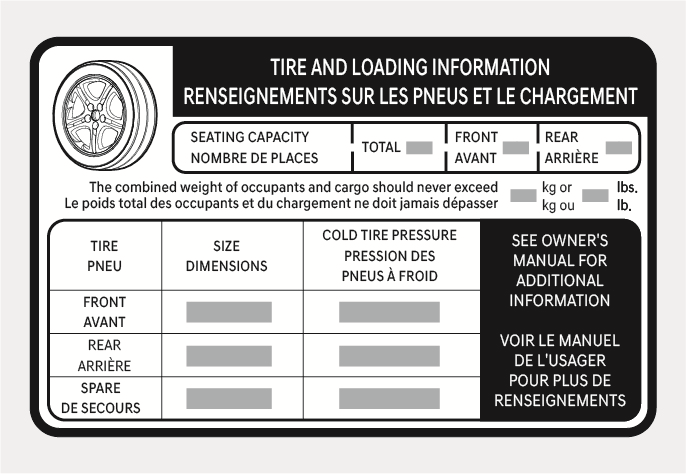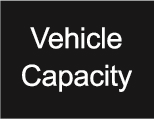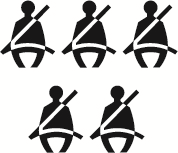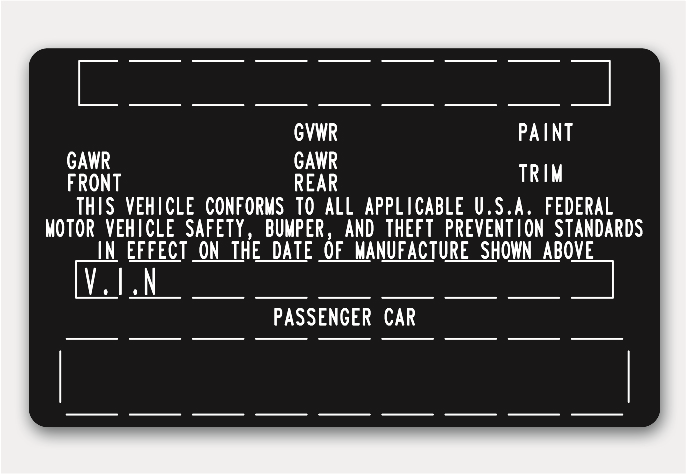The loading information label

2C_TireLabel_1

2C_TireLabel_1

2C_TireLabel_1

2C_TireLabel_1

2C_TireLabel_1

2C_TireLabel_1
The label located on the driver’s door jamb shows the original tire size, cold tire pressures recommended for your vehicle, the number of people that can be in your vehicle and vehicle capacity weight.
-
926 lbs (420 kg)
Vehicle capacity weight is the maximum combined weight of occupants and cargo. If your vehicle is equipped with a trailer, the combined weight includes the tongue load.
-
Total: 5 persons (Front seat: 2 persons, Rear seat: 3 persons)
Seating capacity is the maximum number of occupants including a driver that your vehicle may carry. However, the seating capacity may be reduced based upon the weight of all of the occupants, and the weight of the cargo being carried or towed. Do not overload the vehicle because there is a limit to the total weight, or load limit including occupants and cargo that the vehicle can carry.
With brake system: 3,500 lbs. (1,588 kg)
Without brake system: 1,654 lbs. (750 kg)
Towing capacity is the maximum trailer weight including its cargo weight that your vehicle can tow.
The cargo capacity of your vehicle increases or decreases depending on the weight, the number of occupants, and the tongue load, if your vehicle is equipped with a trailer.
-
Locate the statement “The combined weight of occupants and cargo should never exceed XXX kg or XXX lbs.” on your vehicle's placard.
-
Determine the combined weight of the driver and passengers that will be riding in your vehicle.
-
Subtract the combined weight of the driver and passengers from XXX kg or XXX lbs.
-
The resulting figure equals the available amount of cargo and luggage load capacity. For example, if the "XXX" amount equals 1400 lbs. and there will be five 150 lb passengers in your vehicle, the amount of available cargo and luggage load capacity is 650 lbs. (1400 - 750 (5 x 150) = 650 lbs.)
-
Determine the combined weight of luggage and cargo being loaded on the vehicle. That weight may not safely exceed the available cargo and luggage load capacity calculated in Step 4.
-
If your vehicle will be towing a trailer, load from your trailer will be transferred to your vehicle. Consult this manual to determine how this reduces the available cargo and luggage load capacity of your vehicle.
Do not overload the vehicle because there is a limit to the total weight, or load limit, including occupants and cargo that the vehicle can carry. Overloading may shorten the life of the vehicle. If the GVWR or the GAWR is exceeded, parts on the vehicle may break, and it may change the handling of your vehicle. These may cause you to lose control and result in a crash.
|
Example 1 |

|
≥ |

|
+ |

|
|
Maximum Load (1400 lbs.) (635 kg) |
Passenger Weight (150 lbs. × 2= 300 lbs.) (68 kg × 2= 136 kg) |
Cargo Weight (1100 lbs.) (499 kg) |
|||
|
Example 2 |

|
≥ |

|
+ |

|
|
Maximum Load (1400 lbs.) (635 kg) |
Passenger Weight (150 lbs. × 5 = 750 lbs.) (68 kg × 5 = 340 kg) |
Cargo Weight (650 lbs.) (295 kg) |
|||
|
Example 3 |

|
≥ |

|
+ |

|
|
Maximum Load (1400 lbs.) (635 kg) |
Passenger Weight (172 lbs. × 5 = 860 lbs.) (78 kg × 5 = 390 kg) |
Cargo Weight (540 lbs.) (245 kg) |

2C_CertificationLabel
The certification label is located on the driver's door sill at the center pillar and shows the maximum allowable weight of the fully loaded vehicle. This is called the GVWR (Gross Vehicle Weight Rating). The GVWR includes the weight of the vehicle, all occupants, fuel, and cargo.
This label also tells you the maximum weight that can be supported by the front and rear axles, called Gross Axle Weight Rating (GAWR).
The total weight of the vehicle, including all occupants, accessories, cargo, and trailer tongue load must not exceed the Gross Vehicle Weight Rating (GVWR) or the Gross Axle Weight Rating (GAWR). To find out the actual loads on your front and rear axles, you need to go to a weigh station and weigh your vehicle. Be sure to spread out your load equally on both sides of the centerline.
-
Never exceed the GVWR for your vehicle, the GAWR for the front or rear axle and the vehicle capacity weight. Exceeding these ratings may affect your vehicle's handling and braking ability, and cause a collision.
-
Do not overload your vehicle. Overloading your vehicle may cause heat buildup in your vehicle's tires, possible tire failure, increased stopping distances, and poor vehicle handling. All of which may result in a collision.
If you carry items inside your vehicle (e.g., suitcases, tools, packages, or anything else), they are moving as fast as the vehicle. If you have to stop or turn quickly, or if there is a collision, the items may cause an injury if they strike the driver or a passenger.
-
Put items in the cargo area of your vehicle. Try to spread the weight evenly.
-
Do not stack items like suitcases inside the vehicle above the top of the seats.
-
Do not leave an unsecured child restraint in your vehicle.
-
When you carry cargo inside the vehicle, secure it.